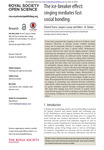The ice breaker effect
| dc.contributor.author | Pearce, Eiluned | en_US |
| dc.contributor.author | Launay, Jacques | en_US |
| dc.contributor.author | Dunbar, Robin I. M. | en_US |
| dc.date.accessioned | 2016-06-25T01:57:00Z | |
| dc.date.available | 2016-06-25T01:57:00Z | |
| dc.date.issued | 2015 | en_US |
| dc.identifier.other | HPU4160284 | en_US |
| dc.identifier.uri | https://lib.hpu.edu.vn/handle/123456789/21663 | en_US |
| dc.description.abstract | It has been proposed that singing evolved to facilitate social cohesion. However, it remains unclear whether bonding arises out of properties intrinsic to singing or whether any social engagement can have a similar effect. Furthermore, previous research has used one-off singing sessions without exploring the emergence of social bonding over time. In this semi-naturalistic study, we followed newly formed singing and non-singing (crafts or creative writing) adult education classes over seven months. | en_US |
| dc.format.extent | 9 p. | en_US |
| dc.format.mimetype | application/pdf | en_US |
| dc.language.iso | en | en_US |
| dc.publisher | The Royal Society | en_US |
| dc.subject | Psychology and cognitive neuroscience | en_US |
| dc.subject | Behaviour | en_US |
| dc.subject | Evolution | en_US |
| dc.subject | Affect | en_US |
| dc.subject | Endorphin | en_US |
| dc.subject | Education | en_US |
| dc.title | The ice breaker effect | en_US |
| dc.type | Book | en_US |
| dc.size | 493KB | en_US |
| dc.department | Education | en_US |
Files in this item
This item appears in the following Collection(s)
-
Education [806]

